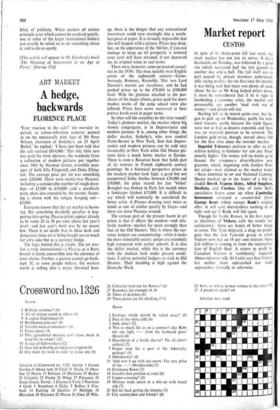Policies and power
BUSINESS VIEWPOINT LOUIS GINSBURG
Louis Ginsburg is Investment Manager of the Legal and General Assurance Society.
In common with the purposes of all other in- vestors, it is a cardinal feature of insurance company operations that assets must Match liabilities; always as to value and broadly as to type, short-term assets, for example, being held against short-term liabilities.
Life assurance liabilities are predominantly of a very long-term nature, extending in some cases up to forty years or even more. A life office is contractually obliged to receive the premiums of its policy-holders and to accumu- late them at interest to meet ultimate payment of its liabilities. A minimum rate of interest is assumed in the calculation of the premiums, and the achievement in practice of at least this rate is crucial to the whole exercise. So far as 'with-profit' business is concerned (and the major part of life assurance business in this country is written in this form), an office will seek to declare and maintain as high a rate of bonus to its policy-holders as its `trading' experience might justify from year to year. In- vestment income, and to a lesser extent capital appreciation, is the main source from which 'surplus' emerges for the benefit of the with- profit policy-holders, and for the shareholders in a proprietary company. Since the funds of the life offices have been increasing steadily for many years, liquidity is not at present a matter of serious concern to them.
In non-life or `general' business—fire, acci- dent, marine and other such forms of insurance —the purposes of the investments are very different. No rate of interest has been allowed to creep into the calculaticin of premiums. The liabilities are short-term, rarely going beyond three years, but the nature and financial mag- nitude of the risks involved make it essential to hold substantial sums in readily realisable form. Apart from a bonus for not making any Claims, with-profit business in the life assurance sense is not transacted, so that there need be no compulsive seeking after the maximum return on the invested assets except as a matter of good business to itiake these assets earn
their keep.
The table below sets out at 31 December 1966 the total assets, fixed-interest and equity reparately, representing respectively the life
and non-life liabilities of insurance companies with head offices in the United Kingdom in respect of business transacted there. A minor distortion is introduced into these figures by virtue of the fact that the investments in public sector securities are taken at nominal value, while all other investments are taken at the value at which they appear in the companies' balance sheets (`book values'), which in the great majority of cases is very close to cost.
£ million Life Funds Non-Life (General) Funds Amount % Amount % Fixed interest 6,559 69 755 70 Equity (ordinary shares and property) 2,955 31 327 30 It is surprising to find that the equity pro- portions (and reciprocally the fixed-interest proportions) are practically the same in each case, despite the very different objectives which the investments are intended to achieve. The explanation lies in the necessity in the general funds (of which the shareholders' capital repre- sents a significant proportion) to secure the maximum long-term return on _the assets em- ployed in order to maintain a reasonable rate of growth in the shareholders' dividends. This it is usually hoped to accomplish by stepping up the proportion invested in equities to a level greater than that which would be required for the insurance reserves alone.
Because of the importance which the in- surance companies have attached to ordinary- share investment, it might be concluded that through these holdings they are in a position to exercise some measure of control over British industry—a rather thought-provoking situation if it were so. An investigation into this point was made by the British Insurance Association in June 1962 by ascertaining mem- bers' holdings of ordinary share, in the 170 companies which then formed the industrial section of the Actuaries' Investment Index, being a very weighty and representative sample of industrial companies. The investigation dis- closed that in the aggregate the insurance offices' holdings amounted to only 11 per cent of the total nominal share capital of these companies. It is probably a little higher today, but not significantly, and it does not therefore appear that the voice of the insurance offices, if it were ever exercised collectively, would be a dominant one in the affairs of more than a very few industrial or commercial under- takings.
Although they are unlikely to dominate any- one, the insurance companies, as a clearly defined and presumably coherent group of in- vestors, are certainly influential holders of ordinary shares. There are divergent views as to whether this influence carries with it the responsibility to keep a close watch on the management of every company in which they are interested as ordinary shareholders, poised to interfere on behalf of all shareholders the moment the profits fail to hold an expected upward trend. The almost universal view seems to be distinctly cool towards interference in such an extreme form, and institutional action is confined almost entirely to an occasional gentle nudge when management is demon- strably not making the most effective use of the shareholders' assets. The circumstances of such interference obviously exclude the possi- bility of publicity. When matters of serious principle arise which cannot be resolved quietly, one or other of the larger institutional holders can usually be relied on to do something about it, and to do so openly.
(This article will appear in Mr Ginsburg's book 'The Meaning of Investment in an Age of Plenty.' [Harrap 35s))







































 Previous page
Previous page